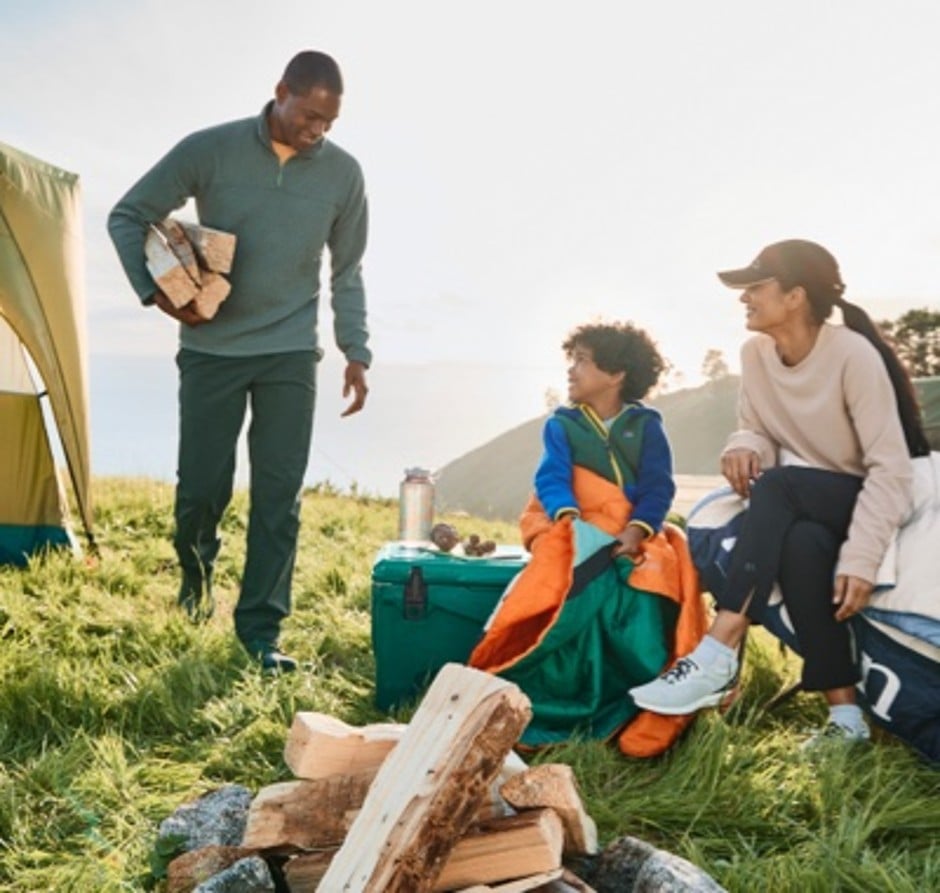(SPEECH)
[00:00:00.11] Hey, I'm Nate, and I'm here to teach you how to start a campfire from scratch.
[00:00:05.24] [MUSIC PLAYING]
(DESCRIPTION)
[00:00:05.41] Nate, a young man in long sleeved lightweight clothes and a baseball cap, sits in a folding chair in a forest next to a tent and ring of rocks. He snaps his fingers and the flames of a campfire start in the rocks. Text, L.L. Bean. How to start a campfire safely. An animation of a car with a canoe on top parking in the forest near a tent. Nate holds a marshmallow on the end of a stick.
(SPEECH)
[00:00:10.66] Getting a fire going is one of my favorite parts of camping, and it's super easy once you know a few basic steps. So pull up a chair and grab some marshmallows. Here's everything you need to know.
(DESCRIPTION)
[00:00:19.83] Text, Preparation. Nate types in a search bar on his phone, fire regulations.
(SPEECH)
[00:00:20.08] Before you start, check local fire regulations and burn bans.
(DESCRIPTION)
[00:00:23.47] A sign posted on a wall says, Don't move firewood. Invasive tree-killing pests can hitchhike on your firewood. Always use local or certified heat-treated firewood, your forest will thank you. A metal fire ring with a grate sits on the ground.
(SPEECH)
[00:00:23.80] Even campgrounds with designated fire rings can sometimes have restrictions in particularly dry weather.
(DESCRIPTION)
[00:00:29.34] A shed is filled with firewood. Nate picks up two bundles of wood.
(SPEECH)
[00:00:29.71] Regulations will also let you know if and where you're allowed to buy or collect your firewood, or if you can bring your own firewood from out of state.
(DESCRIPTION)
[00:00:37.68] Nate's fire burns in a campfire ring of rocks.
(SPEECH)
[00:00:37.96] We're going to be starting our fire in a campfire ring to keep the fire contained and prevent it from spreading. Make
(DESCRIPTION)
[00:00:44.08] Text, Check distance to surroundings.
(SPEECH)
[00:00:44.59] sure your fire ring is clean, clear, and nowhere near any brush, trees, or camping equipment, including overhead.
(DESCRIPTION)
[00:00:52.05] Nate checks the area around his fire ring, moving a chair back and looking overhead. Text, keep water nearby. Nate fills a jug of water from a tap.
(SPEECH)
[00:00:52.39] Finally, always keep a large container of water nearby, enough that you can douse the fire if you need to. The best time to stop a fire from getting out of hand is before it does, and having enough water at hand to do so is essential.
(DESCRIPTION)
[00:01:05.59] Nate kneels next to the fire ring and a pile of wood and kindling.
(SPEECH)
[00:01:06.22] All right, this is one beautiful, safe fire ring. Now, we're going to build something called a log cabin fire.
(DESCRIPTION)
[00:01:13.57] An animation of stacked logs.
(SPEECH)
[00:01:13.82] It's easy to build, doesn't need a lot of effort to maintain, and burns for a long time.
(DESCRIPTION)
[00:01:18.75] Nate proceeds to build his fire in the ring.
(SPEECH)
[00:01:18.83] Start by placing a small pile of tinder in the center of your fire pit. Tinder is the starting point for your fire, small, dry material that lights easily and burns hot. It
(DESCRIPTION)
[00:01:28.31] Examples of tinder are laid out on a table in piles.
(SPEECH)
[00:01:28.58] could be small natural materials, twigs, dry leaves, and pine needles, or something you bring from home, like newspaper, dryer lint, commercial fire starters, or cotton balls dipped in petroleum jelly.
[00:01:40.19] Then place fuel logs on either side of your tinder.
(DESCRIPTION)
[00:01:42.98] Nate places two larger logs on either side of the tinder.
(SPEECH)
[00:01:43.31] These are larger pieces of wood that will burn for a long time, providing your fire with a lot of energy once they're aflame. Place two more logs crosswise to create a square.
(DESCRIPTION)
[00:01:52.67] He places two logs across and on top of the first two.
(SPEECH)
[00:01:52.94] Add a couple more layers of small pieces of wood and kindling.
(DESCRIPTION)
[00:01:55.66] He continues building up the square structure of layered wood. Piles of kindling and wood sit on a table.
(SPEECH)
[00:01:55.91] Kindling is made up of sticks and pieces of wood less than an inch thick. It will burn longer than tinder but still catch relatively easily. It will look like a log cabin.
[00:02:04.43] Finally, create a cone of small kindling over your tinder and use some of your thinnest pieces of tinder to make a roof. Leave lots of space. The fire needs oxygen to burn.
(DESCRIPTION)
[00:02:14.58] Nate builds a tent shape of twigs around his tinder and then places some sticks across the top of the logs. He uses a match to light the tinder.
(SPEECH)
[00:02:15.35] Light your tinder. You may need to blow lightly on the flame to feed it oxygen and get it burning hot.
(DESCRIPTION)
[00:02:20.60] Nate leans on the ground to blow on his fire. The flames burn brightly inside the log cabin structure.
(SPEECH)
[00:02:20.87] The tinder will light the kindling, and the kindling will then light the bigger logs. Once the flames set the kindling cone and roof ablaze, your fire will have a nice, hot core.
[00:02:29.69] Add kindling as needed to keep it burning bright, working your way up to pieces of fuel wood. Once
(DESCRIPTION)
[00:02:34.37] Text, add fuel as needed. Enjoy your fire. He piles more kindling on top of the fire while wearing gloves.
(SPEECH)
[00:02:34.82] your fire is burning, you can simply add fuel wood to keep it going. Avoid wet or green wood, which can produce lots of smoke.
(DESCRIPTION)
[00:02:41.75] He holds the marshmallow over the flames on a long stick.
(SPEECH)
[00:02:42.05] If you're going to cook or roast marshmallows, remember that the core of coals, not the flames, is where you'll find the highest, most consistent heat.
(DESCRIPTION)
[00:02:50.56] An arrow points to the smoldering coals of the fire. Text, extinguishing your fire.
(SPEECH)
[00:02:50.93] All fires, like all camping trips, eventually have to come to an end. Let's put this fire out.
[00:02:56.63] Never leave your fire unattended. Allow it to burn down to the ashes or douse it with your water, being careful not to flood the fire ring. Either
(DESCRIPTION)
[00:03:04.10] Nate pours water from the jug he filled onto the ashes of the fire.
(SPEECH)
[00:03:04.52] way, don't leave your fire until the ashes are cool to the touch.
(DESCRIPTION)
[00:03:07.88] He touches the cooled ashes with his hand then gives a thumbs up.
(SPEECH)
[00:03:08.39] Now that you know what to do, plan some camping trips so you can get out there and start practicing. Like and subscribe to make sure you don't miss our next video, and visit llbean.com/outside for more outdoor tips and inspiration. Now, where did I put those marshmallows?
[00:03:22.61] [MUSIC PLAYING]
(DESCRIPTION)
[00:03:23.50] Nate looks around the campsite. He sits by the fire roasting a marshmallow over the flames.
Before You Begin
CHECK RESTRICTIONS AND REGULATIONS.
Even campgrounds with designated fire rings can sometimes have restrictions in particularly dry weather. Regulations will also let you know if – and where – you’re allowed to buy or collect your firewood.
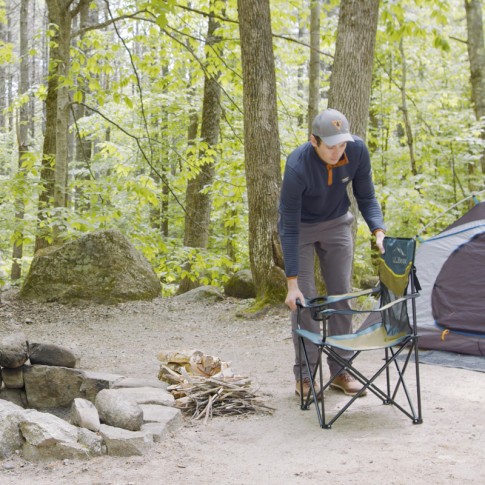
CLEAN AND CLEAR YOUR FIRE RING
Make sure your fire ring is clean, clear and nowhere near any brush, trees, or camping equipment.
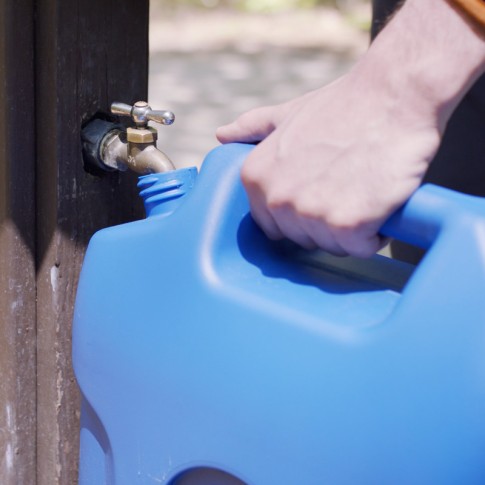
KEEP A BUCKET OF WATER NEARBY
Make sure your fire ring is clean, clear and nowhere near any brush, trees, or camping equipment.
Campfire Materials
TINDER
The starting point for your fire – small, dry material that lights easily and burns hot. It could be small natural materials, like twigs, dry leaves and pine needles; or something you bring from home, like newspaper, dryer lint, commercial fire starters or cotton balls dipped in petroleum jelly.
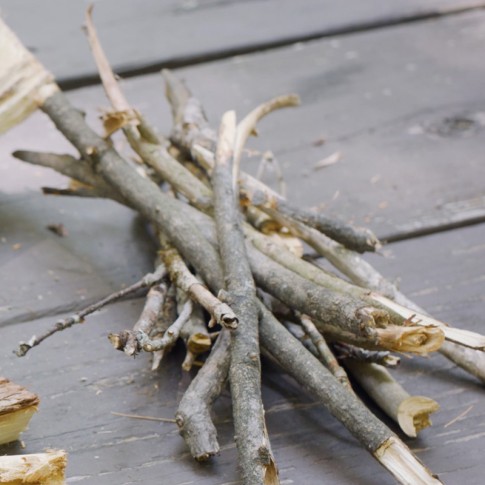
KINDLING
Consisting of small sticks and pieces of wood less than an inch around, kindling will burn longer than tinder, but still catch relatively easily. The tinder will light the kindling, and the kindling will then light the bigger logs.
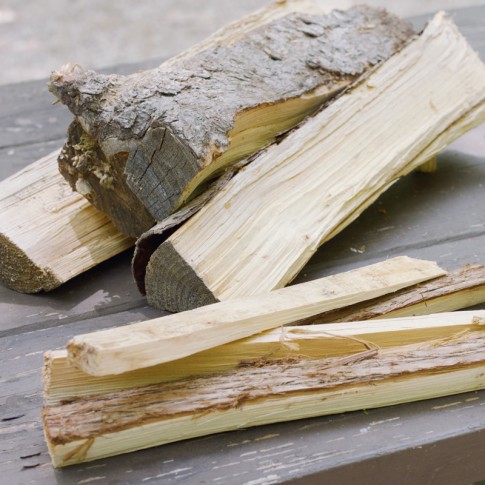
FUEL WOOD
Larger pieces of that will burn for a long time, providing your fire with a lot of energy once they’re aflame.
How to Build a Log Cabin Fire
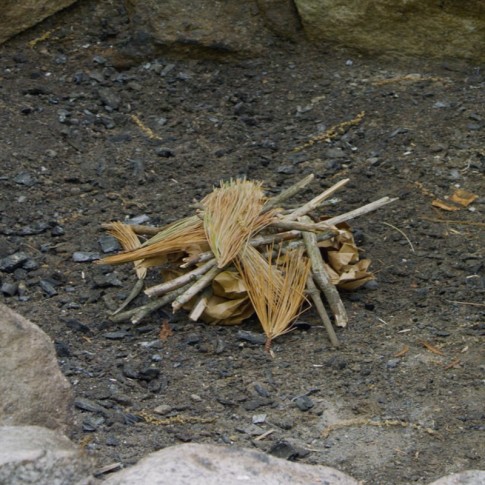
1. Start by placing a small pile of tinder in the center of your fire pit.
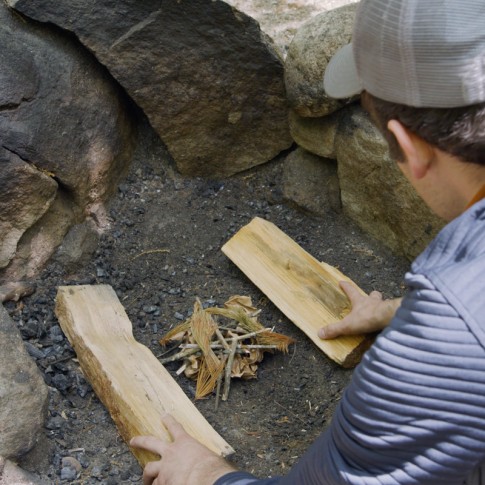
2. Then, place fuel logs on either side of your tinder.
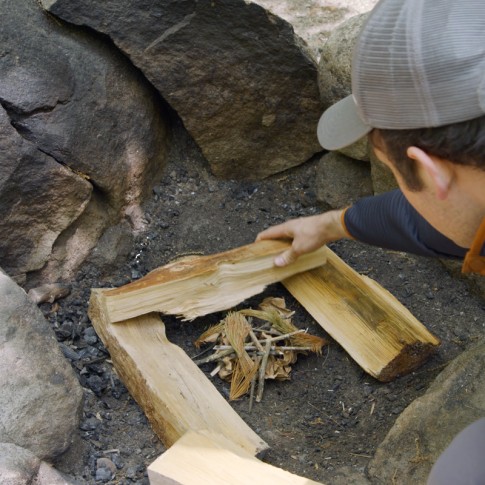
3. Place two more logs, crosswise, to create a square.
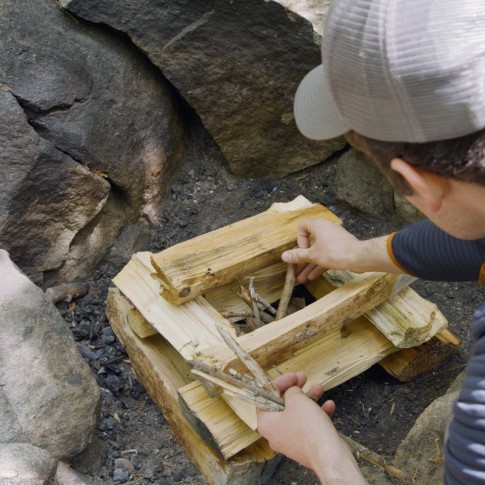
4. Add a couple more layers, using smaller pieces of wood and kindling - it will look like a log cabin.
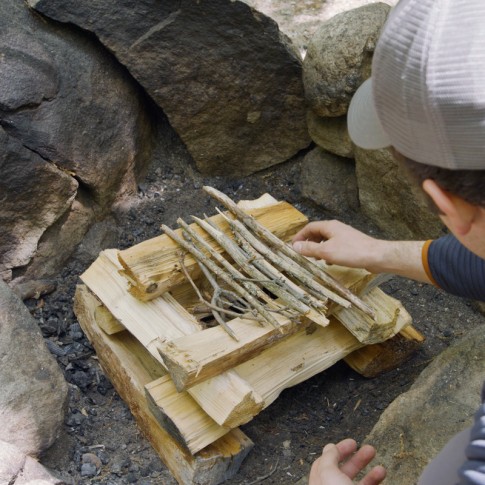
5. Finally, create a cone of small kindling over your tinder, and use some of your thinnest pieces of tinder to make a “roof.” Leave lots of space – the fire needs oxygen to burn.
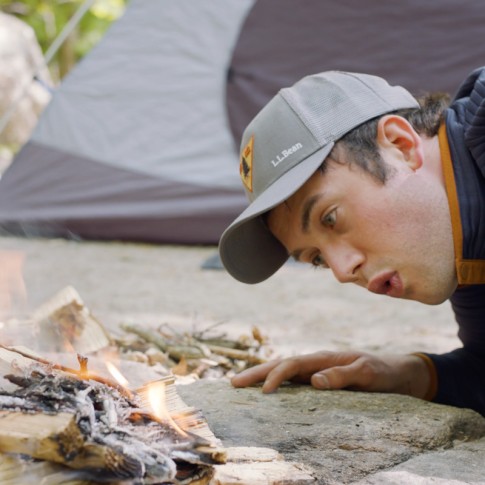
6. Light your tinder. You may need to blow lightly on the flame to feed it oxygen and get it burning hot.
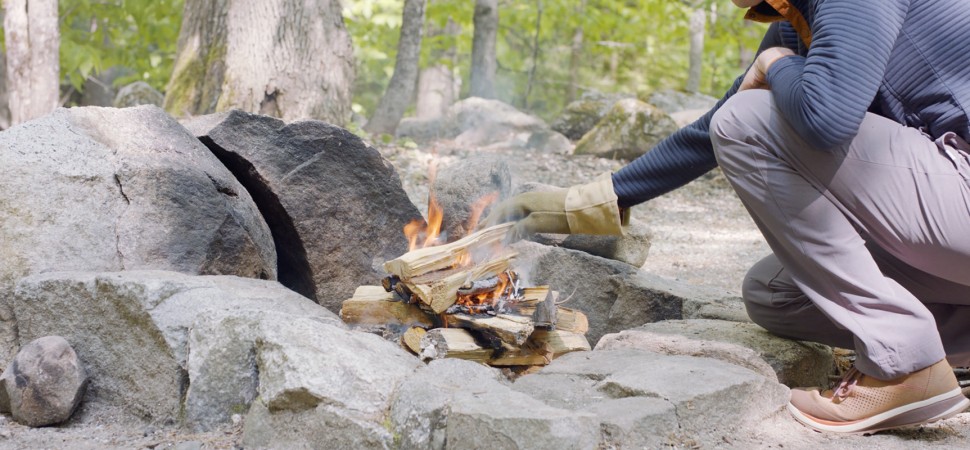
7. The flames should set the kindling cone and roof ablaze, giving your fire a hot core. Add kindling as needed to keep it burning bright, working your way up to pieces of fuel wood.
Extinguishing Your Fire
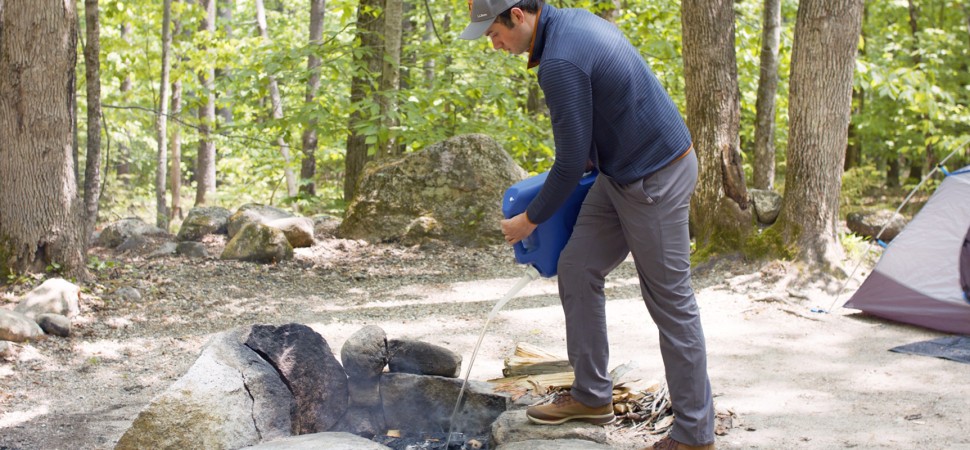
WAIT FOR YOUR FIRE TO BURN DOWN COMPLETELY
Allow your fire to burn down to the ashes, or douse it with water – being careful not to flood the fire ring.
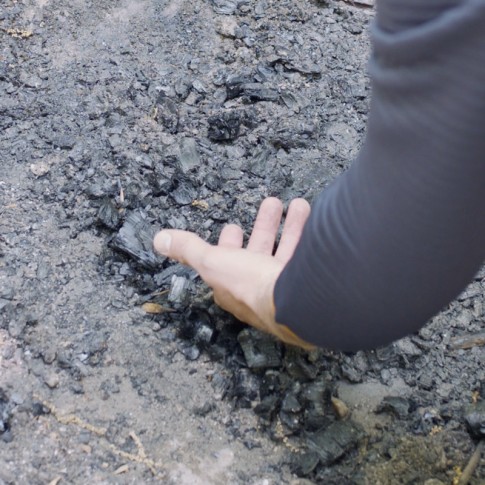
CHECK THE ASHES
Don’t leave your fire until the ashes are cool to the touch. If the ashes are still warm, that means there are still embers inside which could reignite.
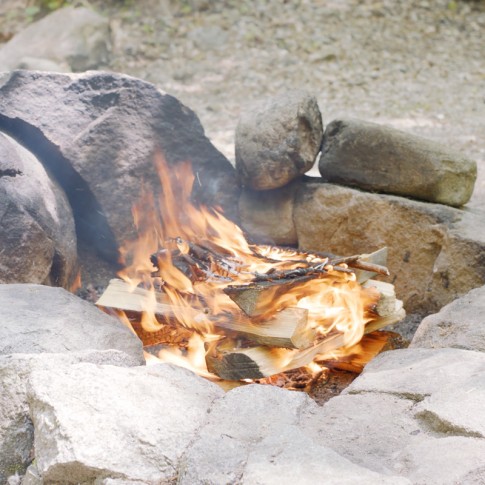
NEVER LEAVE A FIRE UNATTENDED
Whenever you make a fire, keep an eye on it the entire time it’s active. It doesn’t take long for fire to spread – better safe than sorry.
Now that you know what to do, plan some camping trips so you can get out there and start practicing! Making a fire is an essential camping skill – and it’ll get easier every time.
Planning a camping adventure? Get outfitted with everything you need:



